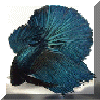





 |
SOLID COLORS: a solid
color betta has only one color (ideally :) ). There are many solids
colors. For the sake of simplicity I sorted them from lighter shade to
darkest shade:
 |
cellophane: basically has no color. Fins are translucid and body is
flesh. The flesh color is due to the fact that one can see the
tissues and organs which are flesh colored. The skin itself does not
have any pigments. |
 |
white opaque: this color was created by Dr. Gene Lucas, who played around
with several genes until the first solid white betta came to be. All
opaques will have varying degrees of red washes as they age, but
when young, they can be immaculate
white. |
 |
yellow: also
known as "non-red" all yellows also carry one of the three
iridescent color (steel, royal or
green). |
 |
orange: this
strain was first created by Gilbert Limhengco and is one of the
latest new solid colors. Oranges are a bit more red than what an
orange would look like, maybe more like a dark tangerine
color. |
 |
red: normal
reds have some black pigment on the body giving them more of a
bicolor look, with a redish/blackish body and red fins. However most
breeders now work with extended red which are intense red from head
to tail, including the pectoral fins
:). |
 |
steel blue: this is one of the three iridescent colors. The blue is
lighter and more "cold" looking, like a greyish blue. |
 |
royal blue: this is the second of the three iridescent colors. Royal blue
is much darker and has almost a purple feel to it. Best see under a
flashlight. |
 |
green: this is the third of the three iridescent colors. Green is
near impossible to detect without a flashlight. Many green bettas
might look black or royal blue at first, but under a light their
iridescent green is
revealed. |
 |
turquoise: everybody is always arguing about this color so let us just
say that turquoise is a color between blue and green, some claim it
is not green, while others claim it is nothing but green. |
 |
black:
there are currently
two different genes that cause a betta to look black. Hence you will
always see either "melano" or "fertile" (aka "lace") associated with
the word black in describing a black strain. Both black melanos and
black lace (or fertile black) look
black. |
BI COLORS: a bicolor
betta has two solid colors. The body will be one color while the fins will
be another.
 |
cambodian:
the body is flesh and the fins are usually red (traditional
cambodian), although blue and black cambodians also exist.
(rare) |
 |
chocolate: the body is dark, usually black but sometimes dark blue and
the fins are yellow |
 |
pastel: there are several variations, such as green pastel or blue
pastel, but in a nutshell, the body is white and the fins are green
or blue, etc... |
PATTERNED BETTAS: a
betta with several color displayed in an organized manner. Bettas with a
bunch of random colors (which most pet store bettas are) are not patterned
bettas and are called multicolors.
 |
butterfly:
The fin is clearly divided in two section: half of the fin is one
color and the other half another color. For example the black/white
BF betta to the left has fins that are 50% black and 50% white (a
very rare combination) and comes from my Dreamcatcher strain. |
 |
marble: The
body and fins have blotches of color over a flesh or any other light
color solid background. For example, black blotches over flesh color
or over white. The photo to the left is that of a red marble from my
apache strain. |
 |
piebald: (aka "white face") The betta
has a flesh face, regardless of his body color. To the left, a steel
blue piebald from my blue apache
strain. |
MULTICOLOR BETTAS: a
betta with a bunch of random colors ( almost all pet store bettas are
multicolors but we often refer to them as "mutts" :)) )
 |
multicolor: (aka "multi")
The betta has
several colors mixed in randomly. They do not breed true, meaning
the fry will not look like the parent. Trying to work these pet
store bettas is a pure waste of time (I know, I've tried!! :) )
Left: a pet store betta with a veil tail displays lavender, red,
blue and white. | |
















